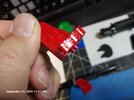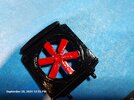You are using an out of date browser. It may not display this or other websites correctly.
You should upgrade or use an alternative browser.
You should upgrade or use an alternative browser.
bubbles in paint
- Thread starter durangod
- Start date
Motoretrolia
Member
- Joined
- Sep 7, 2024
- Messages
- 63
Seems rather thick, was the paint older? Perhaps a drop or two of thinner might help. I don't really see bubbling although if it's there, perhaps it's due to out gassing due to a chemical reaction.
BlackSheepTwoOneFour
Well-Known Member
- Joined
- Jun 9, 2013
- Messages
- 1,026
Both good observations why. Did you stir your paint thoroughly? Sometimes sediments settle at the bottom. Testors small square bottle paint have that tendency to settle on the bottom. I always stir and shake often when I need to use it.
durangod
Well-Known Member
- Joined
- Aug 27, 2024
- Messages
- 455
yes i believe it was too thick and yes most were the bolt pattern for blade connection which are now painted. Thanks.
I also believe that there is some contamination of some kind. As @BlackSheepTwoOneFour stated. I do shake paints but dont stir them.
I say contamination because it happens with spray also. Luckily so far on places not really seen.
Examples two seats, both same primer left one is perfect, right one has bubbles on the front part of the seat at knee level (front square part). Also on the underside of cab (black) My black can was almost empty which may also be part of it, but other cans were not.
Its also possible that i do need to wash larger parts to give extra confidence that it wont happen like on a auto body part, that would be miserable to have to clean and respray.
There are also some tiny specs in the seat diamond pattern like the paint wont stick. But i plan to brush on another color for 2 tone so i think i can cover those.





I also believe that there is some contamination of some kind. As @BlackSheepTwoOneFour stated. I do shake paints but dont stir them.
I say contamination because it happens with spray also. Luckily so far on places not really seen.
Examples two seats, both same primer left one is perfect, right one has bubbles on the front part of the seat at knee level (front square part). Also on the underside of cab (black) My black can was almost empty which may also be part of it, but other cans were not.
Its also possible that i do need to wash larger parts to give extra confidence that it wont happen like on a auto body part, that would be miserable to have to clean and respray.
There are also some tiny specs in the seat diamond pattern like the paint wont stick. But i plan to brush on another color for 2 tone so i think i can cover those.





the Baron
Ich bin ja, Herr, in Deiner Macht
- Joined
- May 12, 2009
- Messages
- 2,239
As far as air bubbles in the paint are concerned, I get them occasionally when hand-brushing, if I've thinned the paint too much. I can brush the bubbles out, and then add a touch more of the paint to the mix to make it a little thicker.
BlackSheepTwoOneFour
Well-Known Member
- Joined
- Jun 9, 2013
- Messages
- 1,026
yes i believe it was too thick and yes most were the bolt pattern for blade connection which are now painted. Thanks.
I also believe that there is some contamination of some kind. As @BlackSheepTwoOneFour stated. I do shake paints but dont stir them.
I highly recommend you do make it a habit to stir then shake. I always do. Shaking the bottle isn't going to loosen the good stuff at the bottom of the bottle.
I say contamination because it happens with spray also. Luckily so far on places not really seen.
Highly doubt there's contamination unless you've added thinner into the bottle by accident.
Examples two seats, both same primer left one is perfect, right one has bubbles on the front part of the seat at knee level (front square part). Also on the underside of cab (black) My black can was almost empty which may also be part of it, but other cans were not.
Its also possible that i do need to wash larger parts to give extra confidence that it wont happen like on a auto body part, that would be miserable to have to clean and respray.
There are also some tiny specs in the seat diamond pattern like the paint wont stick. But i plan to brush on another color for 2 tone so i think i can cover those.
View attachment 125600View attachment 125601View attachment 125602View attachment 125603View attachment 125604
Try putting a little paint in a small pallet dish, add a little thinner especially with those Testors small square bottles. Oftentimes they tend to be thick - even brand new bottles.
airdave
Well-Known Member
- Joined
- Oct 11, 2012
- Messages
- 165
Shaking paint introduces air (and bubbles) into paint, thats why it is never recommended with clears.
(spray bomb clear has such a small amount of paint in the can and a diffusing nozzle, that shaking isn't a problem)
I would think with something as thick as testor's enamels, shaking can easily trap air in such viscous paint.
And then, if you brush it on thick, those bubbles will appear.
As enamel gets older, it needs to be thinned more and more to keep it stirrable and consistent and flowing.
These is how I always worked with Testor's back in the 1970s.
(spray bomb clear has such a small amount of paint in the can and a diffusing nozzle, that shaking isn't a problem)
I would think with something as thick as testor's enamels, shaking can easily trap air in such viscous paint.
And then, if you brush it on thick, those bubbles will appear.
As enamel gets older, it needs to be thinned more and more to keep it stirrable and consistent and flowing.
These is how I always worked with Testor's back in the 1970s.
- Joined
- Sep 4, 2022
- Messages
- 1,077
plastickjunkie
Active Member
- Joined
- May 27, 2010
- Messages
- 121
Your paint is thick and so is the coat (s) you brushed on. The enamel paint needs to be thinned with either mineral spirits, or lacquer thinner to a good brushable consistency, stirring really well to mix it. The trick to using red or yellow paint is to apply a white paint coat first and followed by the red or yellow one. The white paint will enhance the top color and will require less paint. I airbrush my parts to keep paint coat thickness at a minimum which saves details from being covered up with paint thickness. If using this method and using only enamels the white paint needs to fe fully cured otherwise as you brush on the red paint the white cost will be lifted. Sounds complicated but it's not. Airbrushing will produce a superior finish and eliminate any paint lifting being able to top coat within the hour.
The bubbles you describe appear to be molded details. I suggest using paint thinner to strip off the paint and start over. Do not use lacquer thinner to strip the paint cause it will damage the plastic part. The lacquer thinner will not harm the plastic when used as a paint reducer because the amount used is minimal competed to when used for stripping.
The bubbles you describe appear to be molded details. I suggest using paint thinner to strip off the paint and start over. Do not use lacquer thinner to strip the paint cause it will damage the plastic part. The lacquer thinner will not harm the plastic when used as a paint reducer because the amount used is minimal competed to when used for stripping.
Littlemarten
Active Member
- Joined
- Dec 1, 2024
- Messages
- 130
Stirred, not shaken! Shaking is fine for paint thinned to spraying viscosity, but for brush painting, stir, never shake. However, if the paint is at proper viscosity for brushing, the brush painting process will cause the bubbles to break unless the paint is too viscous and the coat too thick.
Now old are these paints? All paints lose solvent over time, especially enamels and lacquers. It needs to be replaced. For enamels, mineral spirits is the best choice. For lacquers, lacquer thinner.
It looks like there are small lumps in the paint, either undispersed pigment or partially cured binder, the latter of which can occur in old paint and will not redissolve. They have to be strained out through a fine screen, or the paint should be discarded and replaced.
When storing paint, make sure the top and threads of the jar are clean, remove any paint on the lid seal, and tighten the lid as tight as you can get it with hand strength. Don't use pliers, they will distort the threads on the lid.
Now old are these paints? All paints lose solvent over time, especially enamels and lacquers. It needs to be replaced. For enamels, mineral spirits is the best choice. For lacquers, lacquer thinner.
It looks like there are small lumps in the paint, either undispersed pigment or partially cured binder, the latter of which can occur in old paint and will not redissolve. They have to be strained out through a fine screen, or the paint should be discarded and replaced.
When storing paint, make sure the top and threads of the jar are clean, remove any paint on the lid seal, and tighten the lid as tight as you can get it with hand strength. Don't use pliers, they will distort the threads on the lid.
Similar threads
- Replies
- 3
- Views
- 157
- Replies
- 29
- Views
- 324
- Replies
- 15
- Views
- 301



